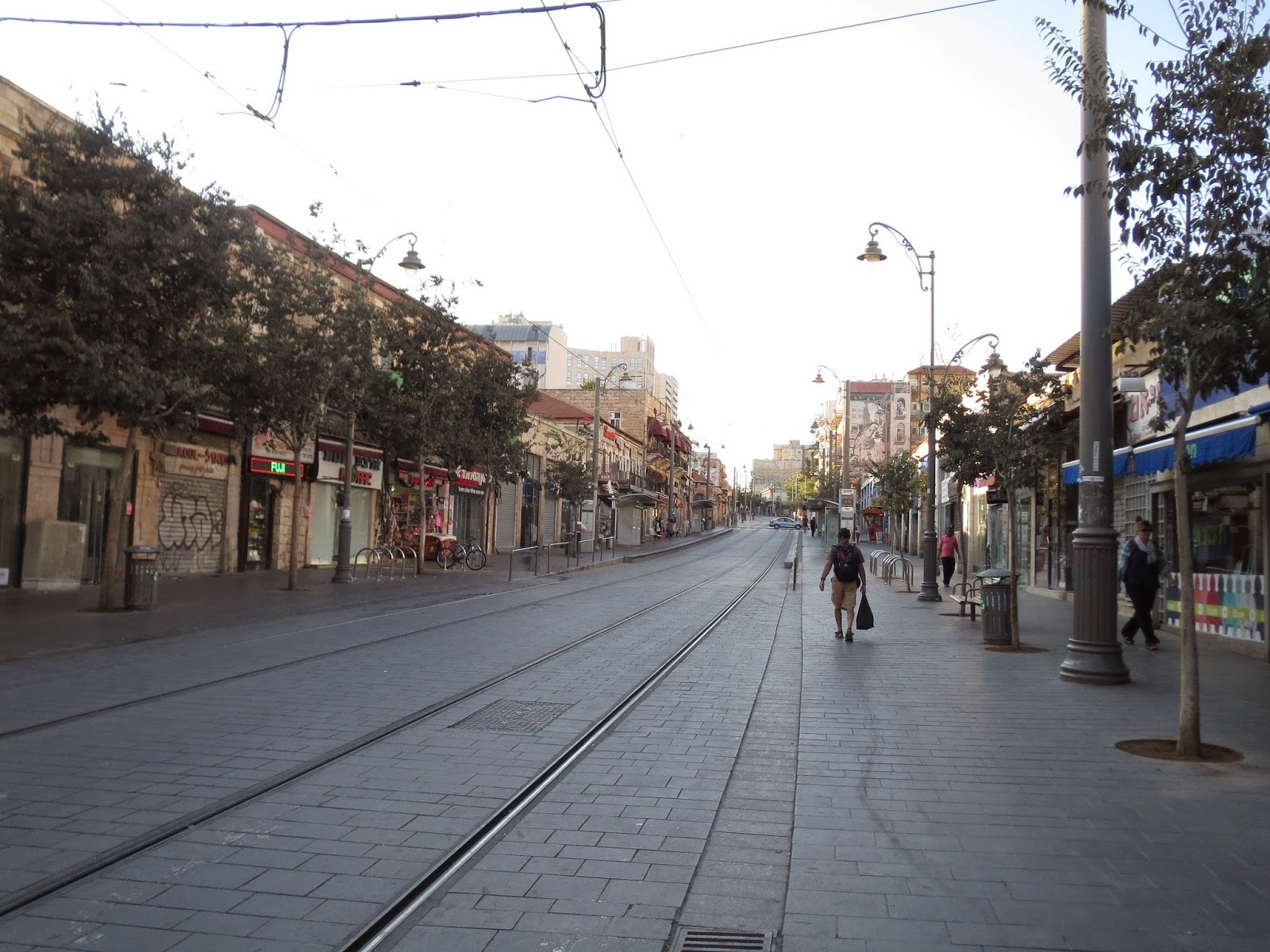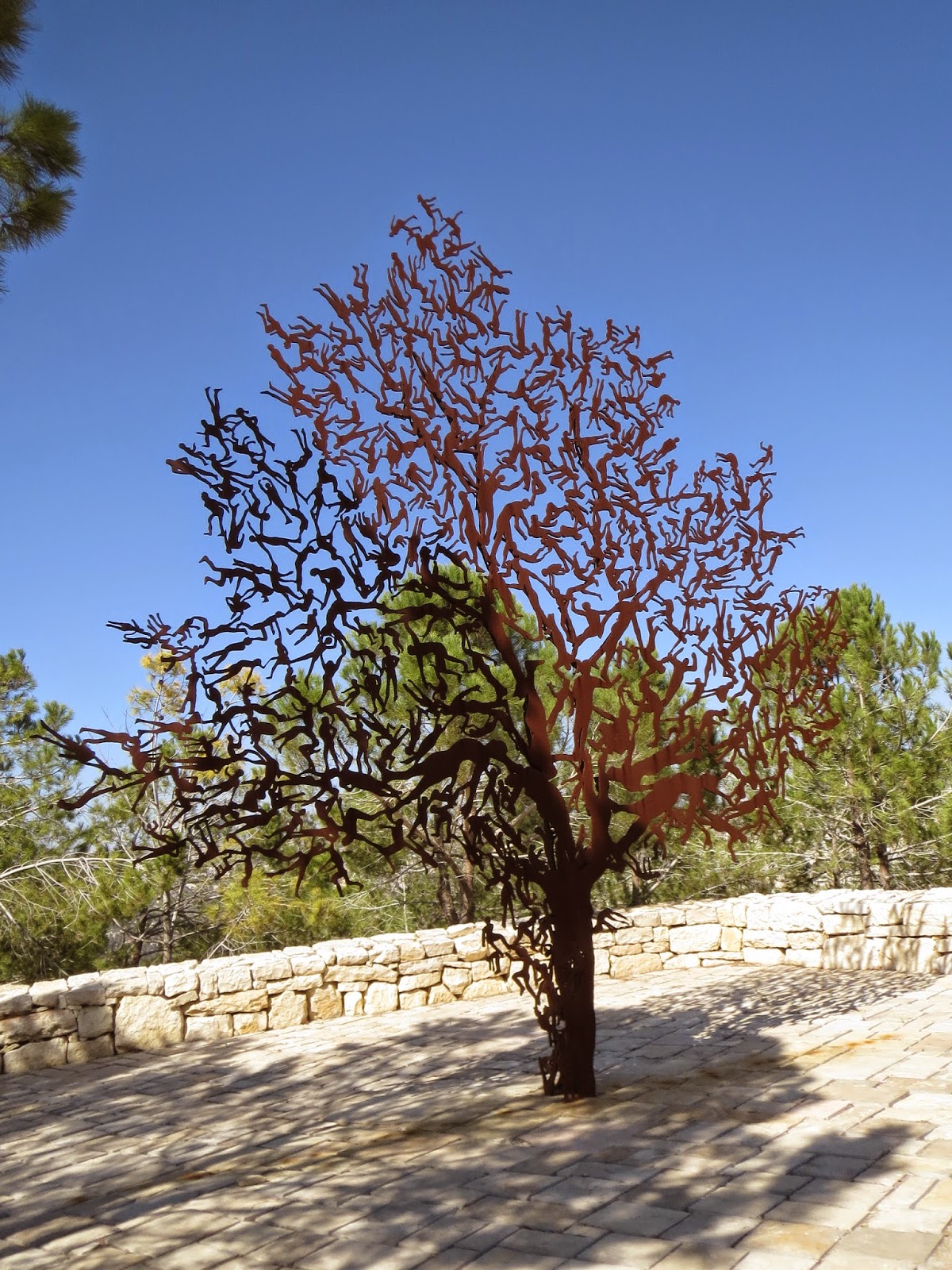On Friday
morning, the 24th, we took the bus over to Yad Veshem wanting to get there at a
reasonable hour before it closed at 2 for the Jewish Sabbath. The experience of
the Holocaust is so deeply seared into the national Jewish psyche that
understanding it goes a long way toward understanding Israelis themselves. The
institution of Yad Vashem, created in 1953 by an act of the Knesset (Israel
This sweet man at
the Visitors Center Information Desk is a Holocaust survivor from We walked fairly quickly through the Holcaust History Museum, a well lit, 200 yard long triangular concrete prism which is the centerpiece of the site because, as readers of the blog know, we’ve stopped at Holocaust Museums in every city along this trip. After a while, it gets very difficult to absorb more of the horrors perpetrated by the Nazis and their collaborators against the Jews, Roma and other persecuted people during WWII.
Two ‘things’ really made an impact on me in the History Museum (below) that were different from what we’d seen before. As no pictures were allowed in the Museum, I wrote them down. One was a poem you may be familiar with written by Martin Nemoller, a German pastor:
"They came for the Communists and I did not object, for I was not a Communist.
They came for the Socialists and I did not object, for I was not a Socialist.
They came for the Jews and I did not object, for I was not a Jew.
When they came for me, there was no one left to object.”
An Anti-Semitic game called ‘Out with the Jews’ also struck a raw nerve for me. In the game, the players follow paths that cross Jewish businesses. A player who lands on them wins a figurine wearing a 'Jewish hat.' The winner is the first player to bring 6 such figurines to the 'assembly point' depicted by a man, woman and child with the caption 'Out to Palestine.'
Approximately 1.5 million Jews fought against the Nazis, as Allied soldiers in the resistance movement and in the ghettoes during WWII. The Monument to the Jewish Soldiers and Partisans is dedicated to the hundreds of thousands who lost their lives in the struggle. The following are photos of sculptures bythe partisan memorial.
 |
| Titled 'In Memory of the Death March from Dachau.' |
 |
There’s such an absence
of color everywhere that seeing these flowers was refreshing.
|
 |
The Children’s Memorial, hollowed out from an underground cavern, is a tribute to the approximately 1.5 million Jewish children who were killed during the Holocaust. As we walked through the memorial, a single pitch black room lit by 5 candles infinitely reflected in 500 mirrors, we heard a recording of names of murdered children, their ages and countries of origin. I found it very unnerving to walk in the room because it was so dark and thought the memorial very stark and frankly disappointing compared to the profoundly touching and emotional Children’s Memorial in
 |
Photo of a boy
who perished at
|
 |
Warsaw Ghetto Square consists of 2 sculptures (one the leader of the Uprising and the other depicting the mass deportation of the Jews to the death camps) set in a wall of red bricks which symbolize the ghetto walls.
The Cattle Car – Memorial to the Deportees was established as a monument to the millions of Jews herded onto cattle cars and transported from all over
Our final stop was Partisans’ Panorama which pays tribute to the Jewish fighters who joined the partisans during the Holocaust. The sculptor chose the tree as a symbol of the partisan fighter whose life depended on the forest and its trees as a place to hide.
 |
Seeing the Panorama
at a distance especially knowing the sculptor’s intention; however seeing it up
close was unsettling to me.
|
We heard the next
day that the police presence was probably so strong because Muslims were
exiting from their holiest day of the
week at the same time Shabbat, or the Jewish Sabbath, the holiest day of the
week for Jews, was beginning so the police were there in force in case of any
altercations.
I had forgotten to mention in one of my earlier posts from Entering the
 |
| We were the only foreigners entering the Old City at this time. |
 |
Arabs sure love
their sweets judging from the number of candy shops in the
|
 |
As we walked
past, these 2 girls said hello to us and asked us our names and said theirs
were Angela and Jessica!
|
We finally knew once and for all we were in the Christian Quarter because so many of the homes had crosses on their doors and one said ‘God Blees our Home.’
We’ve seen men ever since our first days in Turkey carrying glass cups of tea or coffee to the merchants in the bazaars or markets but this was the first time I was able to get a picture of it.
Photo of Amer (pronounced Amir), a shopkeeper in the Christian Quarter I bought some items from at the end of the day on Friday. Steven had just bought a falafel which he was eating while I was looking in the shop. Amir kindly gave Steven, whom he kept calling Brother as do all the other shopkeepers, a can of pop, lots of napkins and a chair to sit on – very astute businessman!
Walking back from Jaffa Gate along
 Walking along
Walking along 











































































Thanks for the photo of my name. I've only met 1 other person with the name Janina. Polish girl
ReplyDeleteThank you again for sharing with all of us. Be safe. Love Becky
ReplyDelete